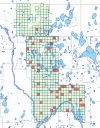The effects of neighborhood density and street connectivity on walking behavior: the Twin Cities walking study
- PMID: 18078510
- PMCID: PMC2228289
- DOI: 10.1186/1742-5573-4-16
The effects of neighborhood density and street connectivity on walking behavior: the Twin Cities walking study
Abstract
A growing body of health and policy research suggests residential neighborhood density and street connectivity affect walking and total physical activity, both of which are important risk factors for obesity and related chronic diseases. The authors report results from their methodologically novel Twin Cities Walking Study; a multilevel study which examined the relationship between built environments, walking behavior and total physical activity. In order to maximize neighborhood-level variation while maintaining the exchangeability of resident-subjects, investigators sampled 716 adult persons nested in 36 randomly selected neighborhoods across four strata defined on density and street-connectivity - a matched sampling design. Outcome measures include two types of self-reported walking (from surveys and diaries) and so-called objective 7-day accelerometry measures. While crude differences are evident across all outcomes, adjusted effects show increased odds of travel walking in higher-density areas and increased odds of leisure walking in low-connectivity areas, but neither density nor street connectivity are meaningfully related to overall mean miles walked per day or increased total physical activity. Contrary to prior research, the authors conclude that the effects of density and block size on total walking and physical activity are modest to non-existent, if not contrapositive to hypotheses. Divergent findings are attributed to this study's sampling design, which tends to mitigate residual confounding by socioeconomic status.
Figures
Similar articles
-
Neighborhood walkability, physical activity, and walking behavior: the Swedish Neighborhood and Physical Activity (SNAP) study.Soc Sci Med. 2011 Apr;72(8):1266-73. doi: 10.1016/j.socscimed.2011.03.004. Epub 2011 Mar 21. Soc Sci Med. 2011. PMID: 21470735
-
Effect of street connectivity and density on adult BMI: results from the Twin Cities Walking Study.J Epidemiol Community Health. 2012 Jul;66(7):636-40. doi: 10.1136/jech.2010.122556. Epub 2011 Jan 17. J Epidemiol Community Health. 2012. PMID: 21242327
-
Perceived Neighborhood Environmental Attributes Associated with Walking and Cycling for Transport among Adult Residents of 17 Cities in 12 Countries: The IPEN Study.Environ Health Perspect. 2016 Mar;124(3):290-8. doi: 10.1289/ehp.1409466. Epub 2015 Jul 17. Environ Health Perspect. 2016. PMID: 26186801 Free PMC article.
-
Stepping towards causation: do built environments or neighborhood and travel preferences explain physical activity, driving, and obesity?Soc Sci Med. 2007 Nov;65(9):1898-914. doi: 10.1016/j.socscimed.2007.05.053. Epub 2007 Jul 17. Soc Sci Med. 2007. PMID: 17644231
-
Investigating associations between physical activity-related neighborhood built environment features and child weight status to inform local practice.Soc Sci Med. 2021 Feb;270:113694. doi: 10.1016/j.socscimed.2021.113694. Epub 2021 Jan 13. Soc Sci Med. 2021. PMID: 33485006
Cited by
-
Neighborhood socioeconomic status predictors of physical activity through young to middle adulthood: the CARDIA study.Soc Sci Med. 2011 Mar;72(5):641-9. doi: 10.1016/j.socscimed.2010.12.013. Epub 2011 Jan 25. Soc Sci Med. 2011. PMID: 21316829 Free PMC article.
-
Differences in transportation and leisure physical activity by neighborhood design controlling for residential choice.J Sport Health Sci. 2019 Nov;8(6):532-539. doi: 10.1016/j.jshs.2019.05.004. Epub 2019 May 9. J Sport Health Sci. 2019. PMID: 31720064 Free PMC article.
-
Regulation of the immune system by biodiversity from the natural environment: an ecosystem service essential to health.Proc Natl Acad Sci U S A. 2013 Nov 12;110(46):18360-7. doi: 10.1073/pnas.1313731110. Epub 2013 Oct 23. Proc Natl Acad Sci U S A. 2013. PMID: 24154724 Free PMC article. Review.
-
Walking Behavior in Temuco, Chile: The Contribution of Built Environment and Socio-Demographic Factors.Behav Sci (Basel). 2022 May 5;12(5):133. doi: 10.3390/bs12050133. Behav Sci (Basel). 2022. PMID: 35621430 Free PMC article.
-
The association between neighborhood characteristics and body size and physical activity in the California teachers study cohort.Am J Public Health. 2012 Apr;102(4):689-97. doi: 10.2105/AJPH.2011.300150. Epub 2011 Nov 28. Am J Public Health. 2012. PMID: 21852626 Free PMC article.
References
-
- Harnack LJ, Schmitz KH. The Role of Nutrition and Physical Activity in the Obesity Epidemic. In: Crawford D, Jeffery R, editor. Obesity Prevention in the 21st Century: Public Health Approaches to Tackle the Obesity Pandemic. New York: Oxford; 2006.
-
- McGuckin N, Srinivasan N. Report FHWA-EP-03-058. Washington, DC; 2003. Journey to Work Trends in the United States and its MAjor Metropolitan Areas 1960 – 2000.
LinkOut - more resources
Full Text Sources
Other Literature Sources


